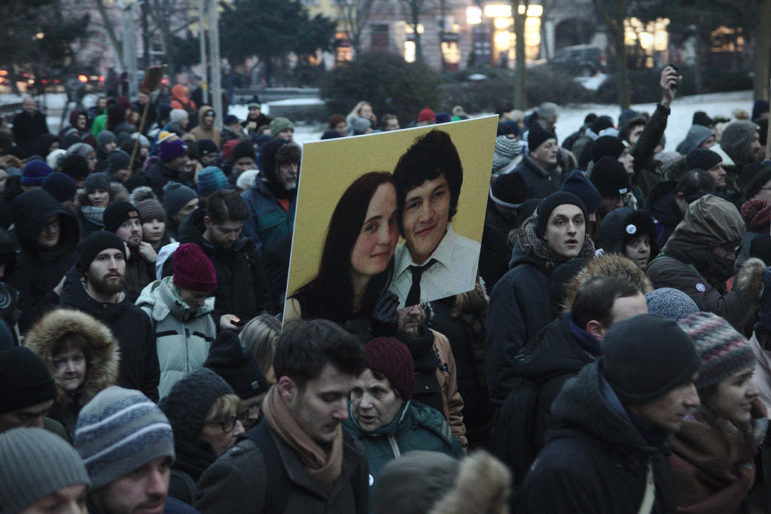
Unsolved Crime: A demonstration in memory of murdered journalist Jan Kuciak and his fiancée Martina Kusnirova, Bratislava, March 2018. Image: Peter Tkac/Flickr
The Slovak authorities are not doing enough to investigate the murder of my friend and colleague. If journalists have to do the police’s job to discover the truth, then we will.
It’s been more than six months since the murder of Slovak journalist Jan Kuciak and his fiancée Martina Kusnirova. The last time I spoke to Jan was only a few hours before an assassin entered his home and put two bullets into his heart. When I learned about his death on that Monday morning, a deep, infinite, paralyzing winter overcame me. I was chilled by the touch of absolute evil. I am still overwhelmed by that feeling. Half a year later, we do not know who killed Jan or who hired his murderer. And I am afraid we’ll never find out.
Murders of journalists are hard to investigate. According to statistics compiled by the Committee to Protect Journalists, 70 percent of journalists are murdered because of the stories they are working on. Less than 10 percent of those murders are ever solved. In comparison, most murders in the Czech Republic and Slovakia have around an 80 percent chance of being solved.
Six months is a critical time frame in which investigators must gather evidence, find and follow leads, and ultimately solve the crime. The Slovak police, however, appear to have done very little and still cannot answer the most basic of questions. Both the police and the prosecutor’s office say an investigation is ongoing and that their silence is necessary to protect it. But the evidence shows otherwise — the police have bungled this case from the very beginning.
According to the Slovak media, they have made significant errors. For example,
- When police arrived at the murder scene in the village of Velka Maca, they neglected to bring a medical examiner.
- That led to the first mistake — they got the date of the murder wrong, and listed it as occurring three days later. It took them three weeks to correct that fact. Meanwhile, investigators questioning people immediately after the murder were asking the wrong questions about the wrong times.
- Police failed to request CCTV footage from cameras in the vicinity of the crime scene. This is absolutely crucial evidence that might have shown Jan’s murderer. Officials only made the request for footage almost two weeks later, on March 4 — well after many cameras had already recorded over the evidence from that fateful night.
- Investigators waited until March 27, a whole month after the murder, to conduct a thorough examination of the area around the crime scene. By this point, crucial evidence such as footprints had been exposed to the Slovak winter for 30 days.
- According to the Kuciak family’s lawyer, Daniel Lipsic, who has access to the investigation file, the police destroyed important evidence at the beginning of the investigation.
“They did not secure the evidence. Some of the evidence was only discovered in the photo documentation (of the crime scene),” Lipsic told Slovakia’s TV JOJ. “Before the crime scene examination, the bodies were tampered with. It is possible that traces of evidence were destroyed. But we will never know.”
The head of NAKA, Slovakia’s anti-corruption unit, Robert Krajmer, about whom Jan had written in previous stories, was among the first officials to arrive at the scene after Kuciak’s murder. Police President Tibor Gaspar tried vehemently to deny that Krajmer had been there, but had to give up when his colleague showed up on footage shot by local television. Krajmer has never given an adequate explanation as to his presence at the scene of the murder that day.
Moreover, journalists have been told that Slovak police have shared almost no information with foreign and international police bodies. They appear to want no help from anyone. This doesn’t inspire confidence that they are trying to find the killer.
Furthermore, half a year later, those state officials who have acted most suspiciously when it came to dealing with the case have been promoted.
Robert Krajmer, an official who should not have been at the crime scene, now has a new job at Slovakia’s Ministry of the Interior. Tibor Gaspar, who was forced to resign from his post as head of police after a public outcry, also has a new post at the Interior Ministry. He’s now advisor to the Interior Minister, Denisa Sakova of SMER, one of the three parties in the country’s governing coalition.
As journalists, we sometimes end up doing the work of the police. In order to uncover corrupt schemes and money laundering, we have gradually learned our own forensic procedures. If we have to learn police procedures for investigating murders to have some idea of what happened that night to Jan, then we will.
There is nothing worse than not knowing. Especially for journalists.
This post first appeared on the Organized Crime and Corruption Reporting Project (OCCRP) website and is reproduced here with permission.
 Pavla Holcová is the founder of the Czech Centre for Investigative Journalism, where she has investigated cases concerning Serbian organized crime, Macedonian secret service investments, and money laundering. A co-recipient of the Global Shining Light Award and European Union investigative journalism prize, she works closely with OCCRP on international projects.
Pavla Holcová is the founder of the Czech Centre for Investigative Journalism, where she has investigated cases concerning Serbian organized crime, Macedonian secret service investments, and money laundering. A co-recipient of the Global Shining Light Award and European Union investigative journalism prize, she works closely with OCCRP on international projects.
